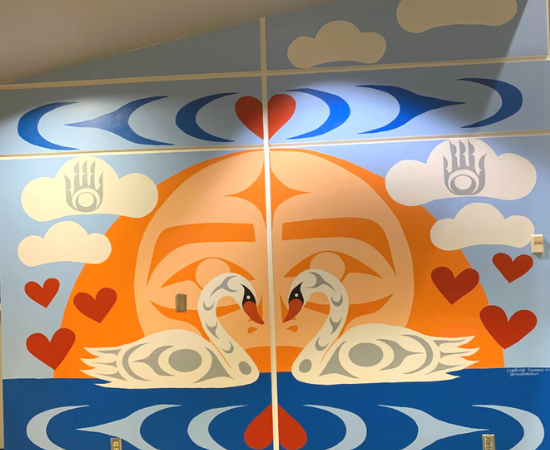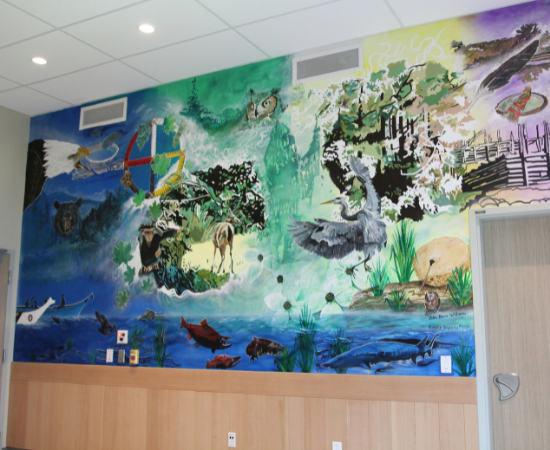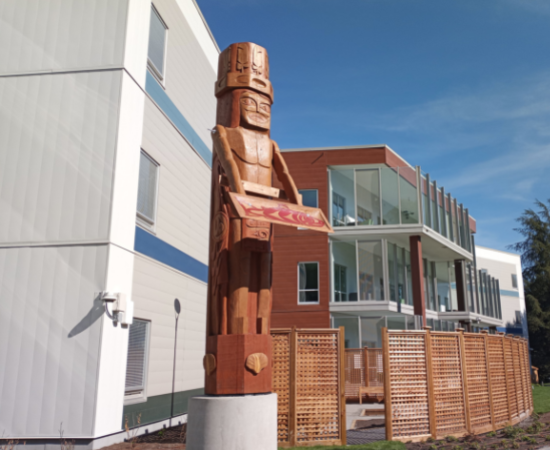From the music we listen to, the movies we watch and the paintings we choose to decorate our walls with: art is all around us. In its multitude of forms, it is a means of expression, understanding, human connection and culture.
“A world without poetry and art would be too much like one without birds or flowers: bearable but a lot less enjoyable.”
– Aberjhani
While art can positively impact our health and wellbeing, it also makes people feel safe. Incorporating Indigenous artwork in our facilities is one of the many ways we can make our health care system more accessible and culturally safe for Indigenous patients, clients and their families. In honour of Indigenous History Month, here’s a spotlight on some of the incredible Indigenous art found across PHSA.

At BC Centre for Disease Control (BCCDC), Quw'ustun artist
Charlene Johnny has painted a memorial mural in honour of Indigenous people who have been impacted by residential schools, day schools and hospitals. She named the mural Tsielth Smun'eem which is a Hul'qumi'num saying about respecting our families.
Each element seen in the mural is thoughtful and symbolic. The ripples in the water and sky represent the ripple effect of inherited strength between generations; the two swans in the center of the piece symbolize the strength, fierceness, and resilience of Indigenous people; and the hearts, hands raised to the clouds, and vivid orange sun are an homage to the common visual themes from the Every Child Matters movement.
Read more about this work here.

At the Red Fish Healing Centre for Mental Health and Addiction, Rosalie Dipcsu-Williams spent 188 hours creating a mural to adorn the wall of the centre’s Hummingbird Room which is used for spiritual and cultural healing activities.
A member of the Squamish Nation and visionary artist and healer, Rosalie’s mural was commissioned by the Kwikwetlem First Nation with the goal of creating a piece that captures nature’s healing power.
“Being able to do this work has been truly special for me; it’s an impeccable moment for my heart,” says Rosalie. “As First Nations people, we see a lot of people struggling with mental health and drug use issues in the community. This room and mural are meant to take the weight off people when they come in here, to help them feel free.”
Continue reading about this mural.

Resting outside the Red Fish Healing Centre, kʷikʷəƛ̓əm (the Kwikwetlem First Nation) has raised and dedicated a house post that tells the stories of their ancestors on their primary land.
The house post, which has been named səmiq̓ʷəʔelə kʷθə šxʷhəliʔ, or Spirit of the Great Blue Heron, represents a warrior carved from a 600-year-old cedar from the Coquitlam watershed. Spirit of the Great Blue Heron will both welcome and watch over clients who come to heal.
Brandon Gabriel, the Kwantlen First Nation carver who was commissioned to carve the post,
tells the story about how the tree was selected here.

Earlier this year, BC Children’s Hospital unveiled a series of new murals which were commissioned by
Live 5-2-1-0—a type 2 diabetes prevention initiative designed to support healthy behaviours among children.
Installed in the main stairwell at the Healthy Minds Centre, the murals are designed to encourage patients and families who are physically able to take the stairs instead of riding the elevator.
The murals, which were created by Stó:lō Coast Salish artist
Carrielynn Victor from the community XwChí:yóm (Cheam), include Coast Salish design elements that reflect traditional values and stories. In addition, they were designed with input from over 60 patients, visitors, and staff to create a sense of connectedness to nature and the outdoors.
Read more about this mural and other Live 5-2-1-0 environmental changes at BC Children’s Hospital here.

Picture: Métis Artisan
Lisa Shepherd and her Métis artwork entitled: Peace: “Walking softly on the Land, wrapped in the strength of our Ancestors,” which is on display at BC Cancer – Vancouver.
In 2017, BC Cancer unveiled Indigenous artwork at its six cancer centres across the province. Each cancer centre has two pieces of art on display—one by First Nations artists and one by Métis artists.
By prominently displaying these installations, BC Cancer aims to signal that Indigenous patients and their families will be treated with dignity and respect and that they can feel accepted and safe from discrimination when receiving care at a BC Cancer facility.

